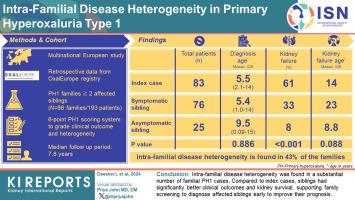Intrafamilial Disease Heterogeneity in Primary Hyperoxaluria Type 1
IF 8.3
2区 材料科学
Q1 MATERIALS SCIENCE, MULTIDISCIPLINARY
引用次数: 0
Abstract
Introduction
Primary hyperoxaluria type 1 (PH1) is known for its variable clinical course, even within families. However, the extent of this heterogeneity has not been well-studied. We aimed to analyze intrafamilial clinical heterogeneity and disease course among siblings in a large cohort of familial PH1 cases.
Methods
A retrospective registry study was performed using data from OxalEurope. All PH1 families with 2 or more affected siblings were included. A 6-point PH1 clinical outcome scoring system was developed to grade heterogeneity within a family. Intrafamilial clinical heterogeneity was defined as a score ≥2. Kaplan-Meier analyses were used to analyze differences in kidney survival between index cases and siblings.
Results
We included 88 families, encompassing 193 patients with PH1. The median interquartile range (IQR) follow-up time was 7.8 (1.9–17) years. Intrafamilial clinical heterogeneity, as defined by our score, was found in 38 (43%) PH1 families. In 54% of the families, affected siblings had a better outcome than the index case. Clinically asymptomatic siblings at the time of their diagnosis had a significantly more favorable clinical outcome based on the authors’ scoring system than siblings with clinical signs and index cases (P < 0.001). Kaplan-Meier analyses revealed that index cases reached kidney failure at an earlier age and earlier in follow-up compared to siblings (P < 0.001).
Conclusions
Intrafamilial clinical heterogeneity was found in a substantial number of familial PH1 cases. Compared to index cases, siblings had significantly better clinical outcomes and kidney survival; thereby supporting the policy of family screening to diagnose affected siblings early to improve their prognosis.

原发性高草酸尿症 1 型的脐带内疾病异质性
众所周知,原发性高草酸尿症 1 型(PH1)的临床病程多变,甚至在家族中也是如此;然而,这种异质性的程度尚未得到充分研究。我们的目的是在一个庞大的家族性 PH1 病例队列中分析家族内兄弟姐妹间的临床异质性和病程。我们利用 OxalEurope 的数据进行了一项回顾性登记研究。研究纳入了所有有两个或两个以上患病兄弟姐妹的 PH1 家族。研究人员开发了一套 6 分 PH1 临床结果评分系统,用于对家族内的异质性进行分级。家族内临床异质性定义为得分≥2。Kaplan-Meier 分析用于分析指数病例与同胞兄弟姐妹之间肾脏存活率的差异。我们共纳入了 88 个家庭,包括 193 名 PH1 患者。随访时间的中位数四分位距(IQR)为 7.8(1.9-17)年。在 38 个(43%)PH1 家系中发现了根据我们的评分定义的脐带内临床异质性。在54%的家族中,受影响的兄弟姐妹的预后优于指数病例。根据作者的评分系统,确诊时无临床症状的同胞兄弟姐妹的临床结局明显优于有临床症状的同胞兄弟姐妹和指标病例(< 0.001)。卡普兰-梅耶分析显示,与同胞兄弟姐妹相比,指标病例出现肾衰竭的年龄更早,随访时间也更早(< 0.001)。在大量家族性PH1病例中发现了脐带内临床异质性。与指数病例相比,兄弟姐妹的临床结果和肾脏存活率明显更好;因此支持家族筛查政策,即尽早诊断受影响的兄弟姐妹,以改善他们的预后。
本文章由计算机程序翻译,如有差异,请以英文原文为准。
求助全文
约1分钟内获得全文
求助全文
来源期刊

ACS Applied Materials & Interfaces
工程技术-材料科学:综合
CiteScore
16.00
自引率
6.30%
发文量
4978
审稿时长
1.8 months
期刊介绍:
ACS Applied Materials & Interfaces is a leading interdisciplinary journal that brings together chemists, engineers, physicists, and biologists to explore the development and utilization of newly-discovered materials and interfacial processes for specific applications. Our journal has experienced remarkable growth since its establishment in 2009, both in terms of the number of articles published and the impact of the research showcased. We are proud to foster a truly global community, with the majority of published articles originating from outside the United States, reflecting the rapid growth of applied research worldwide.
 求助内容:
求助内容: 应助结果提醒方式:
应助结果提醒方式:


